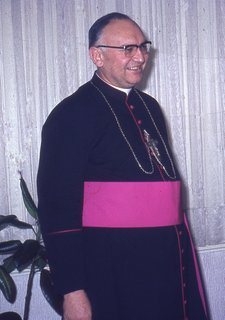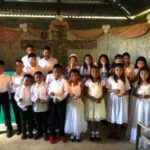Jorge Gottau was born on May 23, 1917 in Estenban Agustin Gascon, Province of Buenos Aires, Argentina. His family, who lived in an area of Volga German descendants, had 11 children.
When he was 12, Jorge entered a junior seminary of the Redemptorist Fathers. He entered his novitiate year in 1937 and made his vows on February 2, 1938. Jorge did his philosophy and theology studies in Villa Allende, Province of Córdoba, and he was ordained a priest on December 19, 1942.
Fr. Jorge’s first assignment was as a parish priest in Darregueira, a Volga German community in the Province of Buenos Aires.
In 1956, Fr. Jorge became provincial superior of the Redemptorists in Argentina.
In 1961, Pope John XXIII decided to create several new dioceses in Argentina, including the Diocese of Añatuya, founded on April 10, 1961. Pope John XXIII chose Fr. Jorge Gottau to be the first bishop of the new diocese, for he knew that Fr. Jorge had the missionary spirit needed for such a poor, rugged diocese. Jorge was consecrated a bishop in 1961. Pope John XXIII also named Jorge to be a “Conciliar Father” in the Second Vatican Council (1962-1965).
When Bishop Jorge arrived in his new diocese, he knew the challenges were great. Physically, he found much of the land barren with temperatures sometimes reaching over 120 F. He also found massive unemployment and underemployment, and many students dropped out of school. Many of the common diseases in the diocese were caused by poverty and a lack of good water. Malnutrition was common, and it led to other diseases of the body such as heart disease.
However, Bishop Jorge was up for the challenge and got to work. By 1964, when he had been in the diocese a couple of years, there were 7 priests and 7 parishes and 160,000 people.
Under his leadership, the priests, assisted by religious sisters and brothers and other lay persons, devoted themselves to making the Diocese of Añatuya a diocese to be proud of. During his 31 years as bishop, the diocese flourished. Twenty-six schools were established. These included 15 primary schools, 8 secondary schools, 2 teachers’ colleges, and a special education. To help give people the necessary skills to find meaningful employment, and not leave the diocese, the diocese established agrotechnical centers, job training centers, and workshops. It also helped form associations for workers to know their rights.
The bishop, priests, and laity also established 15 new parishes and more than 200 chapels, and cooperatives for small rural produces in the diocese.
The diocese helped construct canals, health centers, and facilities to obtain safe drinking water, and it established three radio stations, a sports center, and a cultural center.
One of the things that Bishop Jorge was most noted for was establishing a “More for Less” national collection, in which richer dioceses would collect money to help the poorer ones.
During Bishop Jorge’s tenure, 95.6% of the population were baptized Catholics.
At the age of 75, Bishop Jorge retired in December of 1992. Bishop Jorge died on April 24, 1994 in Buenos Aires, Argentina, and he was declared Servant of God in 2010.



